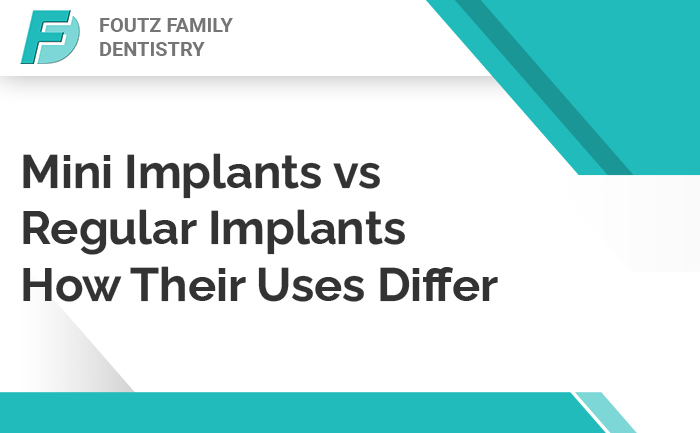
Mini dental implants and regular dental implants both serve the same purpose: they replace missing teeth. Though both mini and regular dental implants provide tooth replacements that can improve your dental health, they differ in some important ways.
What They Treat
Both mini and traditional implants serve the same purpose in the mouth. This purpose is to firmly hold in place a dental prosthesis. Use can be customized based on what the patient’s needs are for prosthetics. Single implants can replace one or two teeth in the mouth. Several implants are used for multiple teeth or to replace a bridge. If a full-mouth restoration is needed, four to six dental implants can be placed to replace an entire lower or upper set of teeth. This can be placed as a removable prosthesis, which can be taken out to eat and clean. Or implants can be placed permanently to more closely mimic natural teeth.
The above can be done with mini or regular implants. The main difference is that mini-implants are a newer invention and are much smaller. Due to that small size, mini-implants typically are less expensive per implant but may require more implants to accomplish the same purpose.
Size and Shape
It might go without saying that mini-implants are the smaller of the two options. A traditional implant post is around 3mm to 7mm in diameter, and a mini-implant is much smaller at 1.8mm to 2.9 mm in diameter. Due to their size, mini-implants place much less stress on the jaw bone and require less healthy jaw bone for support. Mini-implants can be just as stable as the larger traditional implants and when used properly have just as much longevity as the larger implants. As for shape, regular implants feature two parts, an implant body placed in the bone and an abutment. A mini-implant is a one-piece fixture
Qualifications
Based on your current tooth loss and jaw health, patients will qualify for different implants. For traditional implants, you need sufficient bone with the appropriate density, as well as significant space for the larger posts. These parameters help insure that they are successful. So, if you have experienced bone degeneration due to loss of teeth, you may need a bone graft to restore the health of your jaw before undergoing the traditional implant procedure.
Mini implants do not require as much bone width.. Patients with a receding jawbone or degeneration may be able to receive mini-implants without any preliminary procedures like the bone graft. Although for people who struggle with teeth grinding or clenching, mini-implants would need to be used with a removable prosthesis to protect against the forces generated by grinding and clenching. Continual grinding or clenching can weaken any implant system over time if protective measures such as night-guard therapies are not employed.
Procedure
For mini-implants, the procedure is typically done in one office visit without the need for sutures. Traditional implants require a two-step procedure. The first surgery involves your doctor creating a pilot hole for the posts to go in. The second surgery is minor and involves uncovering the post and attaching the abutment. Traditional dental implants can easily support crowns, bridges, and dentures due to their sturdy nature after an appropriate healing time to allow the bone to integrate with the implant. Because in most cases mini implants are used with removable replacement teeth, they can be used for retention right after placement although care should be taken to not over stress them during the initial 6 week healing period
Conclusion
In conclusion, both mini-implants and traditional implants offer the ability to get your smile back. Which way you decide to go just depends on your current jaw, bone and tooth health, as well as your adaptability and budget.
If you have thinning or narrowing bone loss in your jaw, mini-implants may be the best option. If you have issues with teeth grinding or clenching, appropriate protection measures must be employed to ensure longevity no matter which type of implant you receive. Mini implants are great in that they require a minimally invasive procedure, but you may need more of them to receive desired results. Either way, opting for implants can save your jaw health and get you a sparkling smile in no time.









